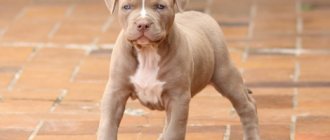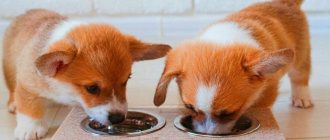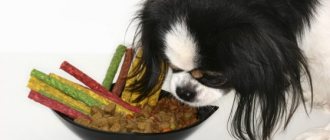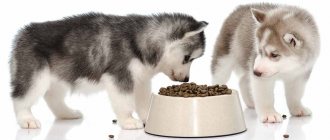Rottweiler - features of the breed
The Rottweiler is a breed of powerful, athletic dog bred in Germany.
The first representatives of the breed performed various functions, but their main task was to protect the owner and his property.
Modern Rottweilers are not much different from their ancestors. Representatives of the breed are strong, persistent and courageous. The Rottweiler sees its role as protecting the owner, all family members and property. It is important to understand that representatives of the breed have short hair, and therefore should not be kept in an enclosure.
Raising a Rottweiler puppy properly is a challenging task. The owner needs to not miss the main stages of formation and development, feed and train the pet correctly. Due to their physiological characteristics, Rottweilers are prone to:
- Osteochondrosis, dysplasia and acquired ailments of the musculoskeletal system (especially with improper feeding).
- Obesity.
- Heart disease – cardiomyopathy due to obesity, aortic stenosis – hereditary.
- Various skin problems.
- Disruption of the hormonal system, including diabetes.
- Indigestion.
- Intestinal volvulus.
The above problems can be either hereditary or acquired. Proper feeding reduces the risk of disease even in old age. During puppyhood, Rottweilers often experience entropion of the eyelids; this problem needs to be addressed as early as possible. For unknown reasons, Rottweiler puppies often suffer from conjunctivitis, which indicates sensitivity of the mucous membranes, and their condition is directly dependent on nutrition.
How to choose the right food for a robust baby
Many manufacturers offer diets for pets, including dogs. But, unfortunately, not all of them are high-quality, well-balanced products. The owner of the puppy can make the task easier and find out from the breeder what kind of food the baby ate before moving into the family. Usually, responsible and experienced dog breeders know which brand of “drying” is more suitable for the dogs of the breed they are breeding.
If the owner decides to switch the pet to a different brand of food, then it is worth waiting with this issue for 1.5-2 weeks until the baby adapts to the new home. More often, owners of large dogs choose the following brands of diets.
Brit
A relatively new product from the Czech Republic, which is produced in 2 lines - Kea and Premium. Brit-premium is a higher-class food; it is chosen by many breeders and dog breeders to feed their four-legged pets. In addition, the manufacturer produces grain-free menus, as well as a special diet for older representatives of large and giant breeds, the formula of which is designed in such a way that the pet will not gain excess weight.
Hills
This is a Dutch-American brand whose products are premium. Breeders of large breeds say that Hill's menu, designed for such dogs, is excellent for animals that do not suffer from allergies. The food contains important elements that maintain muscle and bone tissue in good condition. But owners of dogs with allergies should be careful, as such food can cause an unpleasant reaction.
Akana
Brand of high-quality holistic diets made in Canada. The food for large breeds includes chicken, ocean fish and a number of natural ingredients. Akana has one drawback - its rather high cost, so it is often purchased for dogs that need special nutrition - pregnant and lactating bitches, puppies, dogs with health problems.
Eukanuba
A super-premium product, production is located in three countries: the USA, the Netherlands and Russia. But breeders have different opinions about it: before purchasing a diet for your large pet, you should look carefully at the composition.
Not all recipes of this brand contain natural meat. Often, instead of it there is a dehydrated analogue, or the manufacturer provides general information about the content of animal fats and proteins.
Choosing a place and dishes
The usefulness of food consists of several factors: the quality of food and the degree of its absorption. In order for food to be completely digested by the body, the dog must be healthy, receive food in a timely manner and absorb it leisurely. The last condition is influenced by the choice of place and dishes for feeding the Rottweiler puppy.
The baby Rottweiler should get used to eating in one place and do it calmly. It is important to understand that food aggression is a common feature of the breed, so the owner should be close to the pet while eating. In the first days in the new home, while the puppy is eating, other animals and younger family members should not approach it. When the owner is confident that he can put his hand on the bowl and stroke the puppy while eating, the baby should begin to be fed in the presence of other people and animals.
It is advisable to purchase a special stand for bowls before moving the puppy to a new home. Almost always the stands are equipped with two stainless bowls (for water and food). Despite the potential size of the breed, Rottweilers eat little as adults, so it is better to choose wide and not very deep bowls for the puppy. The height of the stand needs to be adjusted as the puppy grows. It is important to ensure that your pet eats in the correct position, not hunched over or reaching for the bowl. Poor posture while eating results in hiccups, bloating, indigestion and improper bone formation.
As an alternative to stainless steel bowls, you can consider products made from ceramics and high-quality plastic. Ceramic bowls are heavier and require a larger stand. A large plastic bowl or even a small bucket can be used as a drinking bowl.
Eating at home
Adult dog
- First, the dog should always eat in the same place.
- Secondly, for convenience, the bowl must be placed at chest level, using a special stand.
- Thirdly, you need to put two plates, for food and for clean water.
The dog needs to be fed twice a day. Vitamin and mineral supplements should only be used as a course of treatment.
The food norm for a Rottweiler is calculated as follows: 5% of the pet’s total body weight. This figure is divided into morning and evening portions.
It is imperative to create and follow a feeding schedule . Every day the dog must eat at a certain time.
Rottweilers that eat natural food mainly eat meat porridge with vegetables. But if a decision is made to switch the dog to dry food, then it is better to do this at one and a half years, when the bones and joints have already become stronger and there is no longer a need to regularly consume vitamins. The transition is made gradually, by adding products to the finished feed.
Bitch after giving birth
- Immediately after giving birth, the dog can be given only water or, for example, a little sweet tea with milk.
- Then it is necessary to offer food every 6-8 hours, gradually returning to the usual daily dosage, increased by half and distributed over approximately five doses. Food should mainly be liquid. Mineral supplements and vitamins are given until the end of lactation.
- In the first week after birth, it is better to replace meat with low-fat sea fish and cottage cheese. Fresh vegetables and fruits are also not recommended. It is recommended to introduce boiled meat products only on the fifth day; this can be lean meat or offal.
- From the second week the diet is more varied. Vegetables and fruits are introduced.
- From the fourth week, the amount of food and fluid consumed is reduced, feeding 3 times a day. You can also give dry food if it is specifically for nursing dogs. Because it contains a balanced amount of mineral supplements, vitamins and microelements that you need. If mommy develops an allergy, it is permissible to consume special hypoallergenic food.
- When the last puppy is taken away, the woman in labor adheres to a diet for a day, regarding restrictions on water and food (one fourth of the portion is given). The next day - one third of the usual amount of food, then one second, and within five days the dog switches to a normal diet.
Puppy
The first thing to do when feeding your puppy is to create a schedule and stick to it. Puppies should be given food at regular intervals. It is important to make his diet varied. If it is dry food, then for a puppy (up to six months) it must first be soaked in warm water or broth for 7-10 minutes.
Cannot be given to puppies:
- unprocessed milk;
- beans;
- sweets;
- cabbage;
- tubular bones;
- fat;
- flour in large quantities;
- dishes with seasonings;
- roast.
Diet by month
Proper feeding in the early stages is extremely important for the dog. Let's look at what you need to pamper your puppy in the 1st, 2nd and subsequent months of life.
In the first month, the puppies are fed by their mother and this is enough for them . Starting from the second month, giving cottage cheese will be very useful. It is offered first 1-2 times a day, 1/2 teaspoon, then the portions are gradually increased. Buckwheat and rice with milk are also added, cereals can be mixed.
A little later, the dogs begin to be fed with chopped boiled meat. In pharmacies, you can purchase a breast milk substitute and special food for supplementary feeding if you are not able to cook your own food.
- If the puppy does not receive mother's milk at all, then it must be given food 6 times a day every three hours. If the puppy is on natural feeding, then 180-220 g of meat per day is enough for him. It is better to give lean chopped boiled beef along with buckwheat, rice, rolled oatmeal or oatmeal. The daily intake of porridge is 100 g. At the same time, they should be liquid, but with age they can be made thicker.
- Further, the following products are very important for the full growth and development of babies:
- cottage cheese – 150 g;
boiled vegetables – 150 g;
- boiled milk – 400 ml.
- At three months, raw meat, fruits, and vegetables are allowed. A little vegetable oil is allowed. At four months, marine lean fish is already allowed. Food intake per day:
- 350 g meat;
- 0.5 l of milk;
- vegetables, cottage cheese and porridge – 200 g.
- At five months, small changes are made to the old diet. There are already four meals a day. The meat quota is now 500 g. And instead of it, boiled offal is given twice a week.
- From 6 months, the dog is fed three times a day. A serving of porridge – 300 g.
- At nine months, feeding twice a day - morning and evening. Products that make up the menu:
- porridge – 300 g;
- vegetable oil – 30 g;
- cottage cheese – 250 g;
- meat – 500 g;
- vegetables – 300 g;
- chicken egg – 1 pc. ( 2 times per week).
Twice a week, milk should be replaced with fermented milk products and offered 1 boiled egg. Food is given five times a day.
The main thing is to ensure that the puppy’s diet is varied, healthy and balanced.
First feeding
If a woman in labor has milk, but has a lot of puppies, it is better to feed her already from two weeks with prepared cottage cheese in the ratio: 1 liter of milk per 1 liter of kefir (mix and heat to separate the cottage cheese, cool and strain). Offer 2 times a day, starting with half a teaspoon, gradually increase to 2-3 tablespoons and also breast milk.
It is advisable to give drops of “Hilak” , previously diluted with boiled water 5-6 times, 10-20 drops of solution per puppy, or “Bifidumbacterin” in the dosage as for children under one year, before the first complementary foods.
From the twentieth day of life, you can add buckwheat-rice porridge in milk with chopped lean boiled meat to your baby’s diet. All products are introduced gradually, no more than one every day.
How to choose the right ready-made food?
When choosing food, you must always remember that the diet must include:
- offal and meat;
- fish;
- eggs;
- porridge;
- dairy products;
- fruits and vegetables.
To choose the right ready-made food, you must observe the following:
- no need to purchase cheap feed;
- when purchasing, you need to take into account the breed and weight of the pet;
- You must carefully read the information on the packaging before purchasing.
Dry food is more convenient than canned food . They have a longer shelf life.
Thus, we can conclude that their health and development, as well as life expectancy, directly depend on the nutrition of these animals. Therefore, it is necessary to pay special attention to the preparation of the diet and strictly adhere to the feeding regimen.
Rottweiler puppies grow rapidly, so it is important that their diet is balanced and contains all the necessary nutrients. Rottweilers are suitable for both natural products and ready-made food, and it is better to decide on the type of feeding before purchasing a puppy.
What to feed a Rottweiler puppy - choosing the type of diet
To decide what to feed your Rottweiler puppy, you need to choose from three “basic” options:
- Straight.
- Ready-made feed.
- Mixed diet.
All three options have pros and cons in terms of quality, benefit and financial side of the issue. Let's look at the aspects you need to think about in advance.
Natural diet
A natural diet is considered the best option; it has many years of experience of dog owners and menu flexibility. It is believed that natural food is better absorbed. Manufacturers of ready-made food also speak out in favor of natural food, because their products are “almost like natural” or “made from natural products.”
A natural diet for a Rottweiler puppy includes:
- Feeding raw and cooked foods.
- Feeding meat porridge.
- Feeding exclusively raw foods.
The first two options are equivalent. The latter option is called a raw food diet and is becoming increasingly popular. The main idea of a raw food diet is that in nature, no one cooks for dogs. However, domestic dogs do not live “in nature”, and many raw foods will have to be excluded from the diet, despite their benefits.
Benefits of a natural diet:
- Well absorbed.
- Cheaper than feed of similar quality.
- Menu flexibility.
- Ability to regulate calories and fat content.
Disadvantages of a natural diet:
- We need to cook.
- Food does not last long.
- You need to take vitamin courses regularly.
You can start feeding your Rottweiler puppy natural foods from the age of one month. A full expansion of the menu occurs by the age of 10 months. During this period, the dog must try all approved foods. It is important not to waste time and accustom your dog to plant foods.
Ready-made feed
Ready-made food is a reasonable alternative to natural food. The choice of food consists of several stages. To begin with, you need to know that ready-made food is divided into types:
- Dry (granules).
- Semi-moist (pieces with gravy).
- Moist (pate or paste).
- Treats.
The menu of an adult dog should not consist only of dried food or canned food, as this is harmful to the teeth. The most important aspect is the quality of the feed. For convenience, feed quality is indicated by classes
- Economy
- Premium
- Super premium.
- Holistic.
For raising a puppy, food of super premium class and higher is suitable. For everyday feeding, if the dog is healthy, premium and higher food is suitable. The next selection criterion is the purpose of the feed. Everyday rulers have been repurposed for healthy pets ages 1-6 years. If a dog has health problems, food should be selected according to its needs. According to their intended purpose, ready-made feeds are divided into:
- Supportive.
- Preventive (including for dogs prone to excess weight).
- Medicinal.
- For exhausted animals.
Advantages of ready-made feed:
- No need to cook.
- When feeding super premium and higher class products, you don’t have to worry about vitamins and minerals.
- It's easy to calculate the daily requirement.
- Easy to store.
Flaws:
- More expensive than straight.
- If an allergy occurs, the diet needs to be changed and it is not a fact that the appropriate food will be selected the first time.
- Premium food is often too high in calories, which causes problems with excess weight.
- Popular foods are often counterfeited.
A Rottweiler puppy can be fed milk replacer (ready-made food) from birth. Complementary foods in the form of canned food or pates are introduced into the diet from 1–1.5 months of age. Dry food is introduced into the Rottweiler’s diet after the complete replacement of milk teeth.
Mixed diet
A mixed diet involves compiling a menu of natural products and ready-made food. Usually, such a diet is divided into two feedings - drying in the morning, porridge in the evening. The advantage, perhaps, is the convenience of the owner.
There are more disadvantages: indigestion, risk of vitamin deficiency and excess weight gain, dysbacteriosis. In addition, until 4–5 months of age, the puppy’s digestive system is not able to digest food of different textures.
Natural products
Perfect balance
Puppies' diet should include proteins, fats, carbohydrates, vitamins and minerals. Everything needs to be balanced so that the dog’s menu is varied, nutritious and healthy.
Let's take a closer look at how to feed a puppy to avoid shortages or excesses of vital substances in its body.
Squirrels
Meat is the main source of protein. It contains vitamins that promote proper metabolism. Meat improves the dog’s immunity and is responsible for the development of its muscles.
Beef, lamb, rabbit, veal, and boneless poultry are suitable for the Rottweiler. Meat begins to be given to the puppy from two months in boiled and chopped form. From three months of age, raw meat is given, which must be frozen in advance to prevent worms from entering the puppy’s body.
There should be thirty grams of meat per kilogram of dog weight. Let's say a puppy weighs twenty kilograms. Then he is entitled to six hundred grams of meat per day.
At two months old, raw beef or veal bones, preferably cartilage bones, begin to be given. They help strengthen the jaw muscles and speed up the change of teeth.
When the puppy is five months old, two or three times a week the meat is replaced with offal: liver, gizzards, heart, etc.
A four-month-old puppy begins to be fed boneless sea fish. It can be boiled or frozen in advance and served raw. Fish is given no more than twice a week instead of meat.
Starting from two months, the puppy’s diet should include boiled eggs, no more than two per week.
At two months, the baby can be fed with fermented milk products: cottage cheese, fermented baked milk, yogurt, kefir. If the puppy’s body copes with milk, then two or three times a week the fermented milk is replaced with cow’s or goat’s milk. It needs to be boiled for two minutes to get rid of the infection, but retain the beneficial substances.
Brewer's yeast is suitable as a protein supplement - one gram per day.
Fats
The puppy's diet should include fats of plant and animal origin. They promote normal growth. The color and condition of a dog's coat depend on fatty acids and vitamin E.
Sources of fats are sour cream, rendered beef fat, butter, as well as sunflower, flaxseed and olive oil. They can be added to porridges and soups.
A dog needs two grams of fat per kilogram of weight per day. A larger amount of fat can lead to a malfunction of the Rottweiler’s vital organs, making it lethargic and lethargic.
Carbohydrates and vitamins
Carbohydrates fill you with energy, and vitamins strengthen the immune system and are responsible for the proper functioning of the body as a whole. Vitamins are also an excellent preventive measure against diseases and infections.
Carbohydrates are found in bread and cereals, vitamins are found in vegetables, herbs, fruits and berries. One kilogram of Rottweiler weight should contain fifteen grams of carbohydrates and vitamins.
A two-month-old puppy can be given rye bread, soaked in meat broth and served in the form of soup along with meat. It is better to make crackers from wheat bread - fresh bread slows down digestion and can cause constipation. Rusks develop the Rottweiler's jaw muscles and make it easier to change teeth.
For a puppy, starting from two months, you need to cook porridge from buckwheat, rice, pearl barley or oatmeal without adding salt, sugar or spices. For up to four to five months, it is advisable to grind the cereals into powder and cook them in milk or meat broth. An adult Rottweiler will also not refuse milk or meat porridge.
Sprouted grains of wheat or oats will be useful . They need to be dried and crushed before use. This feeding is given once a week, one tablespoon for up to six to seven months.
For up to three months, vegetables should be boiled and served with porridge: pumpkin, beets, turnips, zucchini and others. By the time your puppy is three months old, his body will be able to digest raw vegetables. A fresh tomato will clean your teeth and normalize your coat color. You can also give him grated carrots, radishes or cucumbers mixed with vegetable oil or sour cream.
Fruits should diversify the diet from the age of two months. For example, it is safe to give your dog green apples by grating them for up to three months, and then cutting them into pieces. Berries: currants, raspberries and others can be given in any form - fresh or by making a compote from them.
You need to add finely chopped greens to your salad or porridge: parsley, dill, lettuce, young leaves of dandelion or nettle, and others. In winter, to prevent colds, your Rottweiler can be given one crushed clove of garlic per day.
Minerals
To balance nutrients, the diet should include mineral complementary foods. Sea kale will help compensate for the lack of iodine: half a gram per day up to six months, and five grams after.
Crushed chalk or eggshells will add calcium to the dog's body: half a teaspoon three times a day for a month. Twice a week, separately from food, you can give your dog bone meal, rich in phosphorus and calcium - one gram of flour per two kilograms of the dog’s weight.
Such complementary foods can be easily replaced with ready-made mineral supplements, which are sold in any veterinary pharmacy: Beaphar Irish Cal, 8 in 1, Canina Caniletten. Give as directed.
Liquids
Your Rottweiler should always have access to clean water, especially during the hot season. You can give your dog juices from apples, carrots, and beets.
Sample menu by age
By drawing up a sample menu by age, you can estimate the potential physical and material costs. Let us immediately note that creating a natural diet looks complicated only in theory. To feed your dog natural food, you need time to prepare; if you don’t have it, choose high-quality ready-made food.
Note! Each dog's body is individual, so a sample menu for a Rottweiler puppy does not reflect the full picture. In addition, the pet’s diet needs to be adjusted depending on the degree of activity and the season of the year.
Menu up to a month
Until the age of one month, Rottweiler puppies should eat only their mother's milk. If the babies are orphaned, they are fed with mixed mother's milk substitute or homemade formulas (based on whole milk).
Prepared food
There are several requirements for ready-made food for a Rottweiler puppy:
- they must be premium or super premium;
- you need to buy food from trusted companies: Royal Canin, Brit Premium, 1st Choice;
- until the puppy is six months old, dry food is diluted with meat broth;
- you need to look at the expiration date written on the box.
Food is purchased according to the dog’s age, otherwise the puppy may not receive enough nutrients, and an adult dog may get too much. There are also foods for different situations: “for nursing bitches”, “for old dogs”, “for weakened dogs” and so on. To avoid mistakes, you should always read the instructions written on the box. The daily dose of food is also indicated there.
Additional vitamin and mineral supplements are not required - the ingredients included in the prepared food are already properly balanced. The exception is a deficiency of some substance in the Rottweiler’s body. In this case, you will need to consult a veterinarian - he will prescribe treatment.
Vitamins and supplements in the diet of a Rottweiler puppy
With a natural type of food, vitamins and supplements must be regularly introduced into the Rottweiler’s diet. Natural vitamin supplements:
- Meat and bone meal.
- Clean, dried, crushed egg shells.
- Bran.
- Fish fat.
- Fish, chicken, beef liver.
- Greens, vegetables, fruits.
- Sunflower oil, olive oil.
- Gelatin.
- Brewer's yeast.
Pharmacy vitamin supplements:
- Feed tricalcium phosphate.
- Omega-3, Omega-6.
- B vitamins.
- Undevit and analogues.
To make your life easier, you can purchase special veterinary vitamin supplements for your puppy. The advantage of such drugs is complexity and balance. The most effective way is to alternate several vitamin complexes with different compositions.
Water in a puppy's diet
Water plays an important role in the diet. Rottweiler puppies grow very quickly, so their nutritional and water needs are unexpectedly high. The daily water intake depends on the type of food:
- With a natural diet: 50 ml per 100 g. body weight.
- When feeding dry food: 120–150 ml per 100 g. body weight.
- When feeding wet food: 80–100 ml per 100 g. body weight.
- In hot weather, you need to add 5–15 ml per 100 g to the norm. body weight.
Make sure the water in the drinking bowl is fresh. At least once a day, the drinking bowl must be washed. If this rule is ignored, plaque forms on the walls of the drinking bowl, which is a fertile environment for the proliferation of pathogenic microflora. There are no strict guidelines on water quality, but if running water is hard, it is better to pass it through a filter.
Many owners believe that their dog should only be given bottled water. The argument is that running water can provoke the development of urolithiasis and a number of other diseases. This is true if the quality of the running water is poor. Practice shows that in cities with old communications, running water is technical, that is, it cannot be drunk. In this case, if you do not have a water filtration system in your home, then it is actually wiser to give your dog bottled water.
Ready-made feed
Feeding a Rottweiler with ready-made food is the use of dry and canned dog food manufactured industrially. This feeding method is quite simple and convenient. The owner of the animal does not need to “rack his brains” over creating a menu for the pet - the manufacturer of the finished food has already thought for him. Recommendations and standards for the use of such feeds are usually indicated on the packaging. They depend on the age, weight and living conditions of the animal.
Dry food is available in the form of granules. It is convenient to use and store - such a product can always be bought with a reserve. Dry food is convenient to take on trips if you are traveling with your dog. It contains all the components necessary for the animal’s body. The main condition for using dry food is that the dog must always have unhindered access to a bowl of water.
Canned foods are canned food items. They contain various types of meat, cereals, and vegetables. The composition of canned food meets the needs of the animal’s body and contains all the necessary mineral and vitamin supplements. An open can of food can be stored in the refrigerator for twenty-four hours.
When choosing ready-made industrial pet food, monitor the quality and expiration dates of the products. Use food from well-known and trusted brands. Do not buy a product whose packaging is damaged. Industrial feed must correspond to the breed, age and living conditions of the animal.
Prohibited Products
It is important to exclude prohibited foods from your Rottweiler puppy’s diet:
- Bones, pure fat, skin, especially poultry.
- Palm oil.
- Grapes, raisins.
- Soybeans, legumes and mushrooms.
- Corn and semolina.
- Raw freshwater fish.
- Dry, salted fish.
- Products containing sugar or its substitutes, xylitol, flour or yeast, caffeine, cocoa, stimulants, marinades, salt, spices.
- Smoked products, including sausages, balyki, fish.
- Expired products.
- Leftovers from the table.
- Cat food.
Controversial products:
- Lean raw pork.
- Raw ocean fish.
- Whole milk.
- Honey.
- Chicken eggs.
- Raw and boiled chicken liver in large quantities.
Controversial products can and should be given to a Rottweiler puppy if an allergic or other acute reaction does not occur after taking them.
List of prohibited foods
It so happens that not all foods are suitable for feeding a dog, so it is advisable for owners to know what their pets should not eat. And, naturally, a taboo is immediately placed on treating the dog with food from the owner’s table or feeding the animal with scraps left after a meal.
The following foods are removed from the diet of an adult Rottweiler:
- legumes – often cause excessive gas formation, bloating, and discomfort in the stomach area;
- Potatoes are a vegetable containing a large amount of starch, so when boiled they are very difficult to digest. Dogs can be given raw new potatoes in small quantities;
- confectionery products (sweets, chocolate, etc.) - all sweets harm the animal’s body, primarily by impairing the pet’s vision;
- tubular bones - dogs love them very much, but owners should know that such food is practically not digested by the animal’s digestive organs and can damage the esophagus, stomach or intestinal walls;
- pearl barley is too heavy food for a dog;
- pork - not only does this meat contain a lot of fat, but it can also be a source of parasites that are dangerous to the health and even life of the pet;
- sausages and smoked meats are unhealthy food containing many artificial additives - dyes, flavors, flavor enhancers, etc., and therefore should not end up in the dog’s bowl;
- citrus fruits - experts do not recommend giving them to dogs because of the substances that are used to store fruits - biphenyl, methyl bromide, etc.;
- grapes - can cause fermentation processes in the intestines;
- river fish - it is excluded for several reasons - due to the fact that it is often infected with helminths, many types of fish contain thiaminase - an enzyme that destroys vitamin B, or trimethylamine oxide - a substance that prevents iron from being absorbed.
In addition, you should not give your dog spicy, pickled, or fatty foods, as they can disrupt the functioning of the pet’s digestive tract.











